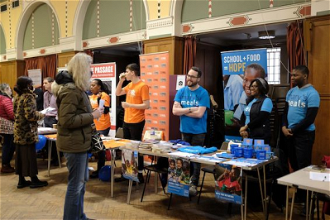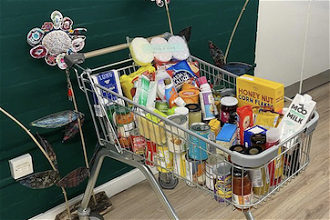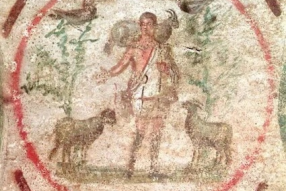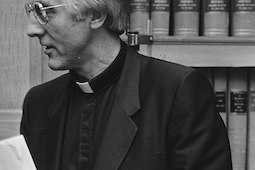Book: Food Most Royal
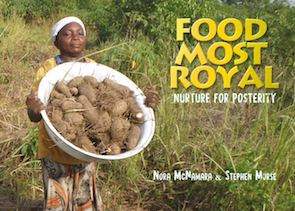
The book - 'Food Most Royal: Nurture for Posterity' - resulted from an urgent ongoing appeal from farmers in Nigeria when in the 1970s they begged for help because their land was dying and their yams were rotting. The terms care of the earth and food security used so often in Laudato si and commonplace now, were not used in the 1970s; but farmers saw exactly what was happening. It was my privilege to be part of a process that responded to their call back then.
As the population increased, unfortunately indigenous trees (like the iroko and other hardwoods) and woodlands were cleared; traditional methods of soil maintenance such as crop rotation were discarded. This was the short sighted approach that Pope Francis now speaks about. The herbalists bemoaned the fact that many of the herbs used for traditional medicinal cures were disappearing as land was cleared. They understood what Laudato si would say later 'different species contain different genes which could be key resources in years ahead for meeting human needs and indeed regulating the environment'. We refer to them as unknown unknowns.
White yam was the staple food and the farmers were extremely worried about what was going to happen. They had identified the problem and they would need to be part of a strategy that found a solution. What applies to white yam here can apply to any other endangered species. In the case of the farmers in Igalaland, Nigeria, they thought some magic medicine could be found to provide an immediate answer but things were not that simple.
The human race is at pains to get more out of a limited resource. However, there are times when this drive to get more, causes loss of a valuable resource, a resource that, once lost, can be difficult, if not impossible, to replace like the herbalists situation above. Short term expediency supersedes long-term thinking. What matters is immediate survival. Immediacy becomes the order of the day and the future forgotten. Live today without tomorrow in mind.
Dealing with problems such as these are difficult and long term as the whole of creation has to be drawn upon in finding a solution. This calls for a global response taking into account interdependency, understanding, co-operation and sharing of competencies between the many organisations that exist today. Indeed, the world is awash with great learning in order to save the planet. But is this still more theoretical than practical?
Let me sound a note of hope. The authors of "Food Most Royal" have come up with some answers in a very specific situation. At least, there has been research into the causes of why yams are dying out in parts of Nigeria and that research is being used effectively by some farmers now. Yes, some soils may still be dying but there are means of keeping the land fertile. In Igalalnd these possibilities have been addressed over the years but it has taken 40 years to bring the different pieces together.
There are still issues that are beyond our control such as terrorist's attacks by cattle herders. Climate change is for real especially as regards drought and flooding within the same year and even the same season. There are internally displaced people in the area for over 25 years because their land is no more. HIVAIDS still has repercussions. People still find it difficult to believe that cutting of trees and destruction of designated forest territory has an impact in another part of the world. A bore hole in place A can cause desertification in place B.
Practical Approach to Care of the Earth and some Solutions for Food Security as identified by some Igala yam growing farmers.
The solution to this whole problem of food security and care of the earth does not happen in a vacuum. In 1970, I was assigned to Diocese of Idah (Igalaland). Cinderella land would be more apt as the region could only be reached by ferries which were not always reliable. Roads were impassable and river transport was often dangerous. Potable water was a major problem especially for women. It was possible to hit oil before finding water in Igalaland.
The Diocese of Idah (which equates in extent to Igalaland) is about the size of Cork and Kerry. Following the Vatican Council in the 1960s, the Holy Rosary Sisters and Canadian Holy Ghost Priests felt the preferential option for the poor needed to be taken seriously and as missionaries to work specifically on the root causes of poverty, hunger, ignorance and diseases etc.
My first job was to learn the language and get an in-depth insight on the situation in Igalaland. I worked within parish structures and local networks especially the indigenous ones.
My guiding principles were liberation theology, Vatican 11 Post Conciliar Documents, and Teilhard de Chardin - the Jesuit paleontologist and geologist who worked to understand evolution and faith.
People had to be the subject and object of their own development. Work with people not for people. Empathy and understanding other points of view was a must even if difficult. Chiefs helped greatly. Significant mentors, role models and leaders all contributed to my learning.
There were many needs and as Igala was a war affected area its people and economy were depressed. The Nigerian civil war ravaged the country. The only means of living for most Igala were subsistence farming and petty trading. The body that coordinated the work was the Diocesan Development Services (DDS) which I set up and coordinated.
Although there were many needs which the Igala people wished to address they did not consider themselves poor. They were a proud people who wished to help themselves. Self-help was very much part of their psyche; it was however highly patriarchal with much emphasis on the elders. It was not easy for younger men to find a satisfying place in the community until they too became elders.
Thankfully, this has changed over the past 40 years.
Women and youth gradually found a place in the DDS projects. It was particularly difficult with yam as it was seen as a man's crop. Despite yam being such a respected and cultural, nutritional staple, guarantying a price that did not fluctuate, the crop received little attention until the problems became more widespread. It took a long time before yam got on to the immediate agenda.
Many improved crop varieties such as maize, beans and other cereals and cassava were introduced by DDS all of which were crops already cultivated locally except for soya beans which were introduced to help human nutrition and improve the soil. In many ways, the DDS predated Robert Chambers (a British academic and development practitioner) with his "Farmer First" approach in relation to letting farmers give the lead in agricultural innovation.
Co-author, Stephen Morse, became a staff member of DDS in the 1980s. DDS had visiting experts from Africa and abroad as well 60 well trained staff who operated at strategic points in Igalaland. DDS reached almost 500,000 farmers by 2005, in groups organised and adapted along the lines of indigenous groups (oja) where there was regular training on all aspects of care of the earth.
This was the first long commitment to the problem of the soil that was dying. There was emphasis on compost making, recycling of nutrients, growing of indigenous trees, especially nitrogen fixing ones. Recycling the dead oil palms added much fertility to depleted soils.
Green legume cover crops which were in danger of extinction got a new lease of life as many farmers remembered how they had been part of the fallow periods in the past.
Special attention was paid to indigenous trees and their role in soil fertility, medicinal treatments and shade. An arboretum was established which managed to regrow some endangered trees and plants. A survey studied the characteristics of 150 trees in Igalaland. A book entitled 'Who Brings Trees Brings Life' was produced where details of 50 of these trees were catalogued giving much local knowledge which is now preserved for posterity The scene was always set with sustainability in mind. Unfortunately, much indigenous technical knowledge is being lost though some of it is talked about in Food Most Royal - see page 85.
From the mid-1980s it was the turn of yams. The International Institute of Tropical Agriculture (IITA), Ibadan was contacted much earlier in relation to the rot. Meanwhile, there was much loss of biodiversity as many varieties became extinct. "Food Most Royal" talks about these issues. DDS and IITA joined forces in research and it became evident that one of the underlying causes of yams rotting was mainly the absence of healthy seeds. Finding a workable solution to clean seeds took many years. Meanwhile, Igala farmers learned and used many techniques for maintaining soil fertility that would be a major contribution to ensuring good seeds found a place where they would grow well.
Then there was a breakthrough in easing the problem of clean and healthy seed yam. The solution appears quite simple, straightforward; once again the idea of using a well-known system for producing clean seed which had become almost obsolete was revisited. This technology is best known as the Yam Mini Sett Technique (YMT). Here a large tuber, as with potato, (a yam tuber is actually a swollen stem) is cut into small pieces and as long as each piece has some skin and a bud it can sprout, grow and produce a new tuber. From this single tuber there is the potential to produce a dozen or more pieces called mini setts. Each of these can produce at least one seed yam.
This is where the researchers come in and have developed various treatment for the minisetts to make sure that they can survive planting and do not pass on pests and diseases to the subsequent seed yams. This treatment has to be carefully done and much training has been provided to ensure it is correctly done. Many farmers are adopting the YMT having seen its value for themselves. It is a means of combatting poverty and women in particular regret that this solution was not found earlier.
Researchers are still examining other methods besides the YMT but most of these are expensive and not affordable as yet. On another cheerful note I hasten to add there are other improvements taking place especially around land use and efficient use of land for yam production. More possibilities are emerging. Once the die is cast, interest grows.
What I have shared is just a practical way of facing the problems identified by farmers as far back as the 1970s and which have now become universal problems. Care of the earth and food security and biodiversity remain major concerns. Some start-up capital for women, widows and families who have lacked opportunities are keen to get involved. There are many educated young people who, with this help, can make life a happier one.
On a final note; are there practical ways of creating synergy around solutions? There are so many initiatives such as the Great Green Wall across Africa and the Laudato Tree Project being promoted by the Society of African Missions and the Tree Council of Ireland. Most religious groups are engaging with the problems of climate change, biodiversity and care of the earth. We still have a worthwhile contribution to make. Is there something that can be done collaboratively by pooling resources?
(Sr Nora McNamara is a member of the Missionary Sisters of the Holy Rosary. This is a summary of a talk she delivered recently in Nano Nagle Place in Cork city. She and Professor Stephen Morse are the authors of 'Food Most Royal: Nurture for Posterity' published by Onstream Publications - www.onstream.ie)




